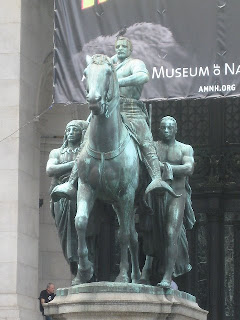
Paris, June 2009—In New York City, in front of the American Museum of Natural History, stands a sculpture of a man on horseback, accompanied by two men on foot. The man on the horse is U.S. President Theodore Roosevelt, naturalist, friend of the museum, and, of course, the soldier who won Puerto Rico, Guantánamo, and the Philippines for the United States. He appears to be dressed in the Rough Rider uniform of those victories.
The other two men are nameless, meant to represent not individuals at all, but continents. A generic African and a generic Native American, they’re leading TR’s horse, and they’re dressed in almost nothing at all. In my youth, during the years that the movement for racial equality was becoming militant, I wondered how that statue, so near Harlem, was allowed to stand, unmolested, not even graffiti’d. No one else even complained about it, at least not publicly
I met its ideological twin in Paris the other day.
More precisely, I met its ideological sextuplets. They’re also in front of a museum, in this case the Musée d’Orsay, and all six of them depict continents: Six larger-than-life female figures representing, from left to right, Europe (yes, Europe comes first), Asia, Africa, North America, South America, and “Oceania.” Like Roosevelt, the statue of “Europe” is somewhat military, despite being female; she seems to be modeled on Athena and is dressed head-to-toe in flowing robes and a suggestion of armor, with a helmet on her head. And, like Roosevelt’s companions, the other five are all half naked.
This is so curious it bears repetition: Seven generic “natives,” created on separate continents and in different centuries, are nevertheless all bare-breasted and accompanying fully clothed white people. What were those sculptors thinking? Surely they never let themselves think what the figures imply …
This is what we know about the sculptures: The Musée d’Orsay sculptures were made for the Trocadero Palace and the Universal Exposition of 1878. Six sculptors were commissioned to create them: Alexandre Schoenewerk, to sculpt the figure representing “Europe”; Alexandre Falguière to create “Asia”; Eugène Delaplanche, “Africa”; Ernest-Eugène Hiolle, “North America”; Aimé Millet, South America; and Mathurin Moreau, “Oceania.” Each did his job; the six works graced the Trocadero during the Exposition and then were discarded and found after the Orsay railroad station was converted into a museum in 1986. The Roosevelt statue was sculpted by James Earle Fraser and placed on the museum plaza and dedicated in 1940.
Those are the bare facts, so to speak. Their meaning would be clear to a child and indeed has presumably been clear to the generations of children who have been taken on school trips to those museums. There is, however, one difference worth noting between the two groups; they are very close ideological relatives, but not quite identical.
The French group was created when Europe truly ran the world, its mastery supported by the ideas shouted by those statues. The group in New York was sculpted just at the moment when the mantle of empire was passing to the United States, which might do well to take to heart the lesson Europe had to learn, the sequel—what empires do after they rise.
They fall.
© Judith Mahoney Pasternak 2009
photo by Brian Pasternak © 2009
No comments:
Post a Comment